 |
|||||||||
Classical Editor: Rob Barnett
Music Webmaster
Len Mullenger:
Len@musicweb-international.com
|
Classical Editor: Rob Barnett
|
||||||||||||||||||||||||||||||||||||||||||||
Classical Editor: Rob Barnett, Spoken Word Editor :Gerald Fenech, Reviewers: Rob Barnett, Ian Lace, Len Mullenger, and: Richard Adams, Arthur Butterworth, Paul Conway, Andy Daly, Tony Duggan, Jane Erb, Gerald Fenech, Lewis Foreman, David Frieze, Malcolm Galloway, Ian Marchant, Gairt Mauerhoff, Humphrey Smith, Colin Scott Sutherland, Andrew Seivewright, Richard Whitehouse, Reg Williamson, Peter Grahame Woolf, David Wright.
CHANDOS October 1999 part 1 |
|
|
For those wishing to print the reviews there are continuously scrolling texts without CD cover graphics here |
||
© Music on the Web(UK) 1999. All rights retained. Reviewers retain copyright on their reviews. Disclaimer
![]() COMPETITION:
WIN a CD of your
Choice
COMPETITION:
WIN a CD of your
Choice![]()
We congratulate CHANDOS on their 20th anniversary and join in the celebrations with reviews of a large number of their recent releases.
SPECIAL OFFER For discs purchased between October 15th to the end of November: Purchase 2 titles from this list for 5% discount; 3 or more titles for a 10% discount.
Georges AURIC Film Music Caesar and Cleopatra*; The Titfield Thunderbolt; Dead of Night*; Passport to Pimlico; The Innocents*; The Lavender Hill Mob**; Moulin rouge**; Father Brown*; It Always Rains on Sunday*; Hue and Cry*. (* - Premier recording ** -Premier recording in this version.) Rumon Gamba conducts the BBC Philharmonic
CHANDOS CHAN 9774 [72:50]
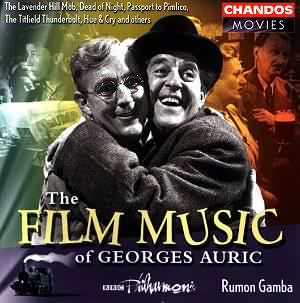
The Film Music - new recordings - suites from:-
Caesar and Cleopatra 1945
The Titfield Thunderbolt 1952
Dead of Night 1945
Passport to Pimlico 1949
The Innocents 1961
The Lavender Hill Mob 1951
Moulin Rouge 1952
Father Brown 1954
It Always Rains on Sunday 1947
Hue and Cry overture 1946.Georges Auric was a member of the celebrated rebellious group of French composers known as Les Six (the others were: Darius Milhaud, Francois Poulenc, Louis Durey, Arthur Honegger and Germaine Tailleferre). Under the influence of Jean Cocteau and Eric Satie, they achieved notoriety for their advanced ideas. Honegger and Auric (and to a lesser extent, Ibert) were prolific writers of screen music, mainly for the French cinema. [Jean Cocteau was famous not only as playwright and librettist but also as a screenwriter and director, with films like La Belle et la Bête and Orphée to his credit.]
In a forty-year film career, Auric composed well over a hundred French film scores and in the latter part of his career scored a succession of big-budget, pan-European co-productions aimed, presumably at the American market. It is, however, with his music for British films that this new Chandos album is concerned.
Auric composed nearly thirty British scores. It has been rumoured that Walton, Britten and Prokofiev all turned down the scoring of the 1945/46 Gabriel Pascal production of Caesar and Cleopatra, starring Claude Rains and Vivien Leigh, after Sir Arthur Bliss resigned form the project. The film was a mess due to the wayward excesses of Pascal who was something of an early Michael Cimino. Auric's music was one of its few saving graces. The nine-minute suite, recorded here, begins with the Main Titles that evoke the glittering waters of the Nile, the sultry atmosphere of Cleopatra's court and her own sensuality plus the majesty and might of Ancient Rome. 'At the Sphinx' is a fine impressionistic piece with very colourful orchestrations including piano, celeste, xylophone, bells, harp, saxophone, tuba, chirping woodwinds, and sultry strings all contributing to a hot house atmosphere of heady seduction and intrigue. 'The Battle' is another colourful and exciting extravaganza that, in places, is reminiscent of Respighi in his Roman trilogy mode.
While Caesar and Cleopatra ground on in post-production, Auric was contracted to score a very different film - the first great British horror film - Dead of Night (1945). This was a portmanteau film that included the story of the demented ventriloquist (Michael Redgrave) and his devilish dummy. Auric's roller-coaster ride of a score is suitably nighmarish and spectral, but not without a wry sense of humour (ghostly horse-laughs and ghoulish glissandos suggesting passing wraiths). There is also a poignant edge to the music suggesting the ventrolioquist's plight and an appealing sugary Ravelian waltz.
Perhaps Auric's best known British score is that for John Huston's 1952 production of Moulin rouge, the story of the disabled artist Toulouse-Lautrec. Auric's music superbly captures all the brilliance and decadence of the legendary restaurant-cum-cabaret, the 'Moulin rouge' with its scandalous can-can dances - and polkas and quadrilles all heard in this nine-minute suite. The film was famous for its waltz song, 'April again, beside the river Seine,' sung endearingly here by Mary Carewe.
It is probably forgotten that Auric scored some of the best-remembered and best-loved British comedies filmed in the famed Ealing Studios. Here they are. The short suite from 'The Titfield Thunderbolt' (1953) is jolly and high-spirited. Just as his colleague, Arthur Honegger, had perfectly captured the essence of the huge locomotive Pacific 231, so Auric marvellously portrays the lumbering and puffing old steam engine of the title. He also brilliantly portrays the colourful characters who champion the threatened railway against the threat of the unscrupulous bus company. The Lavender Hill Mob (1951) is another high-spirited romp. It begins with an imposing, pompous fanfare/march before the music lampoons itself and we are into quieter music of plotting and stealth before the comic-caper robbery music. Auric has a theme of glittering incandescence to portray the gold which is melted down and cast as miniature Eiffel Towers for the French tourist market. The hectic-paced 'The Eiffel Tower' cue music is a mercurial Gallic tour-de-force. Gallic charm pervades the suite from Passport to Pimlico (1949) which again begins self-importantly before Auric's irreverent high spirits take over as the cheeky cockney inhabitants cock a snook at authority and declare themselves the independent state of Burgundy. The score is suitably French-flavoured with some subtle London song colourings. A delight this score. Another merry bustling score came from Auric's pen for Hue and Cry ((1946) which was another light-hearted romp of penny dreadfuls and hordes of children chasing villains across war-scarred London.
In contrast to his comedy scores, Auric composed altogether darker material for the 1961 production of The Innocents a subtle but harrowing horror story, starring Deborah Kerr, and based on the Henry James story, The Turn of the Screw. Auric takes the innocuous old English folksong 'O Willow Waly' and gives it a chill disturbing twist. It is sung here, unaccompanied, by soprano Anthea Kempston. The Main Titles music is equally disturbing beginning with solo oboe and flute singing mournfully in a remote key and other woodwinds joining in with brushed cymbals and eerie high strings circulating around the sound stage to create an opaque and mysteriously threatening atmosphere. More cheerful music underscores the coach ride but the atmosphere chills as Bly House is reached.
Another darker score was penned by Auric for It Always Rains on Sunday (1947). This 14-minute suite is the most extended selection on this album and it is powerful material that should have been recorded long since. Auric cleverly suggests the teeming rain, and not only a sense of tragedy and foreboding, but also Cockney fun, in his Main Titles and Opening Scene music with its stabbing staccato chords suggesting gunfire. There is poignant romantic music for 'Tommy and Rosie' which suggests a hopeless passion. This cue and 'Farewell' have a Debussy-like intensity. 'The Getaway' music underscoring the life-or-death chase of the escaped convict, John McCallum, through the railway marshalling yards is exciting indeed. Younger film music composers could learn a thing or two from this inventive chase music.
Finally there is another great and cheerful Auric score that should have been recorded ages ago - that for the Ealing-like Father Brown (1954). This film starred Alec Guiness as the mild provincial Catholic priest who has phenomenal powers of detection. Very appositely the Father is pitted against a French master criminal 'Flambeau' allowing Auric, once again, to demonstrate his cross-channel versatility. Auric's colourful, busy score combines an appealing Poulenc-like insouciance with more serene material to suggest Father Brown's piety and 'The Cross of St Augustine.' The Channel Crossing and the cheerfully evocative 'Train Journey to Fleurancy' music are particularly appealing.
This is a very welcome addition to film music enthusiasts' collections. The BBC Philharmonic play with great enthusiasm and conviction under their young conductor Rumon Gamba. The sound is first class too, revealing this music for the first time in all its vibrant colours. [British film music recording techniques of the 1940s and 1950s left a lot to be desired too many scores sounded muffled and thin.]
Highly recommended.
Reviewer
Ian Lace

and Rob Barnett adds
This disc takes us through one aspect of Auric's film music. He wrote only 30 scores for British films. There are 100 or so other continental scores including Rififi (1954) and La Belle et la Bête (1946). As one of the group of French composers known as 'Les Six' he has a reputation as a joker and a bit of a flâneur. This disc shows that he has a wider span of accomplishment.
The Cleopatra music is richly impressionistic and impassioned with a hint of Irishry at least once - a tribute to G.B. Shaw perhaps? The Titfield Thunderbolt score starts jokily but the middle section (Triumph) has a few memories of Honegger's Pacific 231 and indeed I am sure I caught a hint of Eine Kleine Nachtmusik as well. The title bars for Dead of Night are out of the same book as Mossolov's Zavod. This is fearsome music of machines - wild and imposingly tempestuous with perhaps a presence from the Valkyries. Passport to Pimlico echoes with memories of rural France and one can speculate that this brightness which I also associate with Canteloube's orchestral Auvergne arrangements had its impact on the young Malcolm Arnold. Respighi's Pines and Mossolov's music of machines meet in the exuberant finale.
The ethereal riches of Anthea Kempston's soprano chimes across the music in The Innocents, catching the slightly boomy effect of a boy alto. The nerviness of machine music is also there in the Coach Ride plus the gracious dip and bow of Ben Frankel's Carriage and Pair. Both machine rhythms and Respighian excess hit you between the eyes (ears?) in The Lavender Hill Mob. To this is added an English pastoralism and the rush and scramble of the chase scenes at the Eiffel Tower. The end-titles have a baroque trumpetry grandeur.
Moulin Rouge's minatory storminess soon departs in favour of a sweet tune. This melts into the Belle Epoque celebration and flouncy petticoats which returns in the final Quadrille. Mary Carewe's Waltz Song is sweetly sung and fortunately escapes the operatic style which would have killed this song stone dead. Whoever was responsible for selecting Mary Carewe should take a bow. This is touchingly done. An instant hit and must son catch the attention of Classic FM as should all of the tracks on this collection.
Father Brown's music is dashing - catching the spirit of Dickensian London (yes, I know the novelist is G.K. Chesterton). The Train Journey (interesting that trains played a part in Auric's life rather like Goossens and Moeran) and the finale are much affected by railway beats and machine rhythms.
There is a substantial suite from It Always Rains On Sunday initially rosily sentimental but this soon fades into a mechanistic nightmare like a great steam engine with pistons out of control and the governor broken. The overture (all the other films are represented by suites) from Hue and Cry is a champagne gambol through the alleys of London. From the music the locale could just as easily have been Paris. In this mood Satie (Parade), Milhaud (Boeuf sur le Toit) and Ibert all jostle each other.
I was not surprised to see that this collection had been restored by the redoubtable and heroic Philip Lane who had the full cooperation of Mme Michèle Auric.
This is a comprehensively enjoyable collection and will appeal, given half a chance, well beyond the confines of the film score enthusiasts. Do please get it. The collection has a generous playing time and recording quality of the finest.
Reviewer
Rob Barnett

J.S.BACH Lutheran Masses (Vol. one) Susan Gritton, Robin Blaze, Mark Padmore & Peter Harvey with Purcell Quartet & instrumentalists
Chandos Chaconne CHAN 0642 (59 min)
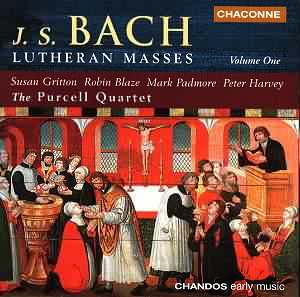
Bach's four "user friendly" shorter masses, which omit the Credo and take around half an hour each, have always been over-shadowed by the B minor Mass, even though they contain some of the finest music of his Leipzig years. They involve re-cycling of earlier music on German texts. Such self-plagiarism was common at the time (Handel often did it) and was perfectly respectable.
Intimate performances, with solo singers for the choruses and one player to a part, have become commoner since research by Joshua Rifkin and his advocacy of this approach. These are all highly rated musicians on the British early music scene and there is an admirable immediacy in this attractive CD of the A major (BWV234) G minor (BWV235) Masses. There is no named director, but the instrumentalists include such stalwarts as Catherine Mackintosh and Stephen Preston. The dance source of so much of Bach's music is evident from the first Kyrie, which sets the feet tapping. However, it does sound like a studio CD rather than a real performance and I find the voices a little too forward. There is full, learned, documentation including details of each instrument used.
Reviewer
Peter Grahame Woolf

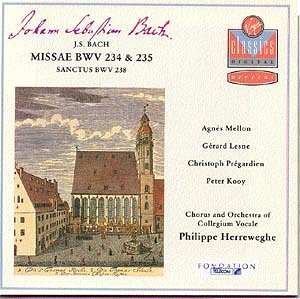
J.S.BACH Lutheran Masses (Vol. one)
Agnes Mellon, Gerard Lesne, Christoph Pregardien & Peter Kooy with Collegium Vocale Chorus and Orchestra conducted by Phillippe Herreweghe
Virgin Veritas 7595872
The same two masses are included in a recording by Phillippe Herreweghe and his Collegium Vocale of 18 singers and a similar number of instrumentalists from Ghent, which I acquired after they gave the four Lutheran masses and the B minor in London. Whilst I do not want to enter into controversy or embark upon detailed comparisons, I prefer Herreweghe's approach and his use of a small orchestra and soloists to contrast with choir, as is more traditional - though in Bach's day they would probably have come forward from the ranks of the choir to sing their solos. The recording conveys a hard to define feeling of long and deep association with his regular team of collaborators, nurtured through numerous live concert performances. Herreweghe finds room for an additional Sanctus (BWV 238) which helps to tip the balance. Recording is excellent and background information fully sufficient.

Peter Grahame Woolf
J.S.BACH Lutheran Masses (Vol. one) Agnes Mellon, Gerard Lesne, Christoph Pregardien & Peter Kooy with Collegium Vocale Chorus and Orchestra conducted by Phillippe Herreweghe
Virgin Veritas 7595872
EDGAR BAINTON (1880-1956) Symphony No. 2 (1940) [27.21] HUBERT CLIFFORD (1904-1959)) Symphony (1940) [42.49] JOHN GOUGH (1903-1951) Serenade for small orchestra (1931) [2.14] BBCPO/Vernon Handley
CHANDOS CHAN 9757 [72.30]

The CD era from 1983 onwards and particularly over the last ten years has seen a positive explosion of musical riches. Works known only from lists in music dictionaries have become auditory reality. The chance to explore and discover has been extended to anyone for the cost of a CD.
This disc marks yet another step forward in documenting what can loosely be called the British musical renaissance. Some may quibble at that word 'British' as Clifford and Gough were Australians (though both spent significant amounts of time in the UK) and Bainton emigrated to Australia in 1934.
For those fortunate (as well as tolerant) enough to have discovered the symphonies from private archival or off-air tapes these works will not come as a total revelation. For most people this music will be completely unfamiliar so a few words of orientation and musical triangulation may well help.
Everything here is melody-centred. Clifford wrote film music and several lighter orchestral works. Bainton's language is similarly tonal but with lashings of Baxian impressionism.
The Bainton Symphony is the second of his three. Its Baxian language is sultry and mixes in a cool Finzi-like pastoralism and perhaps reaches towards Frank Bridge's Summer and two Jefferies Poems. The eruptive flute figure is typical of Bainton. It appears also in the Third Symphony. The language flickers into Debussy (La Mer) territory as well. The Track 4 Maestoso recalls Bax in warlike Rosc-Catha mood as well as cross-referencing to Bax's Fifth Symphony in triumphal mood and this can also be heard in the piu lento of track 10. The hushed rush and shiver of the molto vivace is strikingly memorable and returns for the allegro vivace. The poco piu mosso slides in and out of woodland ecstasy. The rippling woodwind and harp of the adagio might almost have come from the pages of Bax's Spring Fire or Summer Music or Happy Forest. The lento section (track 11) takes much from Bax's Garden of Fand. The tolling molto maestoso might well have been inspired the spine-chilling music Franz Waxman wrote for the animator scene for The Bride of Frankenstein and this returns to close the work with a sense of horror and victory; the last element twisted with an Irish accent.
The Gough Serenade is the briefest of opalescent gems. Its easy relaxation coasts along in leafy repose - a chip off George Butterworth and RVW Dives and Lazarus.
The Clifford work is simply glorious and the recording conspires to give it the best chance of registering with us catching the throaty woodwind and the abrasive punchy brass. The musical reference points include Walton's First Symphony, the Rootham Symphony (No. 1), a dash of Bliss and Prokofiev. The first movement beats with romantic life darting and vigorous. Handley gives the work an estimable voltaic charge which propels it forward. The Scherzo (II) is similarly restless. The Adagio is the longest movement (over 15 mins) although not for a moment is there a hint of creative sprawl. Concentration is never in doubt and this is well caught in the performance. The finale bustles along with a syncopated confidence that recalls Bliss in the Colour Symphony and Sibelius 2 and 5. The Clifford Symphony can be loosely grouped with dramatic contemporaneous works such as the Arthur Benjamin Symphony and Goossens' No. 1.
All the works on these discs are recording premières. They have never been commercially available in any medium. Both the Bainton and the Clifford exist in private recordings but their circulation has been very slender.
Now, Chandos, what about turning your attention to Bainton's 'chef d'oeuvre', his Third Symphony. This was recorded commercially during the dawn of the LP preserving a concert performance with the Sydney SO conducted by Sir Bernard Heinze. It is a work with a visionary mien and a power encountered in the sixth symphonies of Vaughan Williams and Bax. It is also a work that demands utter commitment from its conductor and orchestra. I can think of no better match than Handley and the BBCPO.
Two previously unrecorded wartime symphonies flanking an even lesser known serenade recorded in excellent sound and in no-compromise performances.
Self-recommending.
Reviewer
Rob Barnett

AMY BEACH (1867 - 1944) Piano Trio Op150, Piano Quintet Op 67, Theme and Variations for flute and string quartet Op 80 The Ambache
CHANDOS CHAN 9752 [64.16]

There is something highly commendable about Amy Beech as a person. She married a prominent Boston surgeon in 1885 and always wished to be known as Mrs H.H.A. Beach and not Amy Cheney. Although a contemporary of Dame Ethel Smyth, the two women could not be more different in character. Smyth was bellicose, argumentative and dangerous in her eccentricities whereas Beach was a contented woman who had a tremendous moral stance and was very compassionate. She was widowed at 43 and found inspiration in the Episcopalian church. She studied in Germany for three years before the outbreak of the First World War. In fact it is the Germanic seriousness and romanticism that infuses her work.
Clearly her Piano Quintet owes a great deal to Brahms' F Minor Quintet and it is a competent and pleasant work, and beautifully played here but it is not original and could have been written by anyone with Brahms as a model before them. Occasionally, the music has a sort of Palm Court sound. There is no music of this time that is original such as Max Roger for example ... but we must 'balance the scales' and not dismiss Beach as merely old-fashioned although she was. I always find it difficult when a composer dismisses the work of Bartók and Hindemith, two giants of the 20th Century ... which Beach did.
On the other hand, her music is well structured and has a coherence as well as an obvious appeal. It is vastly better than some British Victorian and Edwardian composers.
The Theme & Variations comes from her partsong, An Indian Lullaby. It is another piece with a 'warm' sound; it is very pleasant and again has a coherence, and these features are most welcome, but there is really no memorable material. It is almost 'mood' music. It is easy on the ear and, as a result, becomes tedious.
A little expansiveness is an asset to the Piano Trio but, again it is very pleasant if not much else. All the harmonies are predictable; there is nothing neither new nor compelling. One can be bored with bland pleasantness. Music needs bite!
Reviewer
David Wright
Performances

Recording

ERNST VON DOHNANYI (1877-1960) Suite in f sharp minor (1909) [28.42] Variations on a Nursery Theme * (1913) [24.31] The Veil of Pierrette suite (1909) Howard Shelley (piano) * BBCPO/Mathias Bamert
CHANDOS CHAN 9733 [69.52]
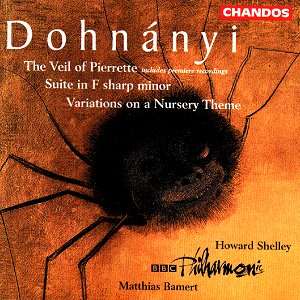
After hearing this superbly varied celebration of the artistry of Ernst (or Ernö) von Dohnanyi I am enthusiastic about exploring further. I am intrigued by the possibilities offered by his two violin concertos (perhaps to be coupled in Hyperion's romantic violin concerto series). And the two symphonies - the latter already available from Chandos (CHAN 9647+9455)
This is music of sheer delight and the BBCPO and Bamert must take a deep bow. The suite mixes the playful Brahms (St Anthony Variations and Academic Festival) with super velour work for the wind instruments. The drama of Brahms 1 also gerts a look in as does the innocent exaltation of Nutcracker. Listen to the mellifluous flute at 6.13 and the pre-echoes of Franz Schmidt's Hussar Song Variations in the scherzo. In III a sinuous slave girl dance winds exotically in and out. The final rondo is a Brahmsian helter-skelter scurry.
The well-known variations are witty and again mercurially varied. The influences include the torment of Brahms 1, flickering and floating waltzes, a boosy bassoon and piano duet (9), a Viennese Sugar Plum Fairy arranged for miniature hurdy-gurdy, grandeur and amusement. The moods melt and sweep along and Howard Shelley is as alert as we would expect from such a masterly player whose artistry has never been restricted to the box-office standards.
The Pierrette music is again bursting with variety. Gloom and charm bruise shoulders. The affluent ballrooms of Vienna rub along with a distinctly Mahlerian (although also merry) funeral march. The young Sibelius is also there - not such a strange thing bearing in mind that a number of Sibelius's early triumphs were in Germany. The wedding waltz finale's grand strings may well have been influenced by Elgar's Introduction and Allegro of four years previously However this is just a scene-setter for an over-top luxury waltz - all done with breathless élan.
The sound quality is typically superb and well up to the usual house standards. Arachnophobics may like to approach this disc with care. Odilon Redon's smiling but hungrily leering spider decorates both the disc and the cover! Recommended.
Reviewer
Rob Barnett

Antonín DVORÁK (1841-1904) Symphony No. 8*, Nocturne for Strings*, ,Overture: In Nature's Realm † ,Carnival Overture† London Philharmonic Orchestra* Ulster Orchestra conducted by Vernon Handley
Chandos CHAN 7123 [68:07] Reissues from 1983 and 1985
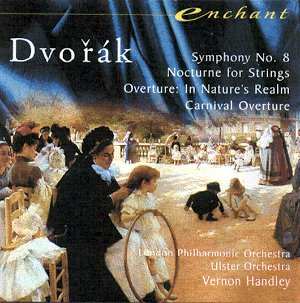
It really must be hard to imagine a more melodic symphony than this full of beguiling tunes that spin around in the head for days especially those two sparkling dances that comprise the Allegretto grazioso third movement. Handley's reading of these is ravishing. In fact this performance is, for my money, as good as any you will hear. He introduces a much-needed sense of dramatic intensity and mystery into the first movement thus pointing up the contrast between the more sunny and joyful elements.
Handley even manages to make the weaker final Allegro ma non troppo with its rather banal military figures sound interesting. There are currently over sixty entries for this popular symphony in the R.E.D. catalogue. The Gramophone 1999 Good CD Guide prefers: Mackerras, Järvi (again on Chandos, recommending his readings of all the Dvorak symphonies - but beware the book wrongly attributes these to Handley!); Masur, Abbado and Ancerl.
Handley also delights in the idyllic pastoral evocation, with its myriad birdsong, that is the Overture: In Nature's Realm with its lovely lilting main melody. He also rejoices, excitedly, in the hustle and bustle of the country fair that is the subject of the Carnival Overture. Yet he does not neglect the voluptuous or the darker more dangerous aspects of this exciting overture. Finally, the elegant string playing of the London Philharmonic Orchestra distinguishes Dvorak's lovely Nocturne for Strings which was one of the composer's first works to captivate British audiences.
A confident recommendation
Reviewer
Ian Lace

ALEXANDER GLAZUNOV (1865-1936) Symphony No. 1 (1881) Violin Concerto (1903)* Julia Krasko (violin) * Russian State SO/Valeri Polyansky
CHANDOS CHAN 9751 [59.12]
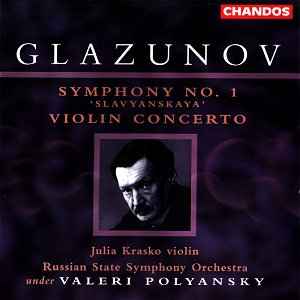
I first became a Glazunov enthusiast as a result of hearing the violin concerto in a Decca recording (LP 1970s) of Jose Sivo. After that I pursued every bit of Glazunov I could trace. There is still a great deal more to hear but among the symphonies particular favourites of mine are numbers 5 and 8. The late saxophone concerto is also well worth tracking down.
The present rather fine disc is part of a steadily unrolling cycle. Numbers 4 and 5 came out very recently (I write in September 1999) and Number 2 plus the Coronation Cantata was issued a year ago. Given Polyansky's predilection for broader tempi I am particularly looking forward to the grandeur of his account of the Eighth Symphony.
The present disc gives us his 1881 symphony - the work of a prodigy. The premiere was conducted by Rimsky-Korsakov. It is Rimsky who is credited with having given a strong guiding hand and his influence and that of Balakirev is felt throughout the symphony. Glazunov was a fine colourist as his ballet The Seasons testifies. He had a special sympathy with the Kouchka and his dazzling completion of the Borodin 3rd Symphony is a far more accomplished work than some rather sniffy commentators infer. As for the first symphony the present performance makes for it one of the most successful arguments I have heard. The tempo is usually on the broad side as is often the case with Polyansky. Rozhdestvensky on Olympia has more vibrant pizzazz but the Russian melancholy is better conveyed by Polyansky and the RSSO. The recording, rather recessed but responding well to a volume boost, is the last word in refinement. Chandos have long put behind them the sometimes rather over-rich and congested sound accorded to the Bax symphonies.
The Violin Concerto is probably the market leader at present. Certainly it is close to the top of the league and it is more sympathetically coupled than many. The dancing horns of the opening bars did not at first seem to bode well. They were set so far back by comparison with other favourites. However the moment Juliet Krasko's deft and succulent-toned playing entered the proceedings the impression changes. This is a most vibrant and successful performance. There were times, especially during the flaming finale, where it seemed to me that Krasko was goading the orchestra into a new access of excitement. The orchestra and conductor seem to be bucked and jolted along. The result sets the pulse racing without destroying the poetry of this lovely piece relegated by ignorance to the ranks of the second or even third league concertos.
Reviewer
Rob Barnett

ALEXANDER GLAZUNOV (1865-1936) Symphony No. 4 (1893) [32.16] Symphony No. 5 (1895) [34.45] Russian State SO/Valeri Polyansky
recorded Moscow April and November 1997 CHANDOS CHAN 9739 [67.08]
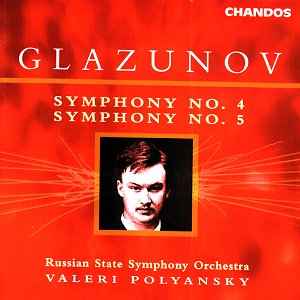
We too easily forget Glazunov's world-wide success. His symphonies in particular had repeated performances during the 1890s and 1900s in the USA and especially in the UK. Glazunov himself travelled widely to conduct these works. Sir Henry Wood in London was a strong advocate and a staggering number of multiple performances were given conducted by Sir Dan Godfrey at Bournemouth. Gradually in the 1960s through the export of various Melodiya performances Glazunov's star began to rise from the abyss into which it had sunk. Ivanov and Fedoseyev had LPs issued in the UK via EMI. Later a reputedly very fine set (reckoned by the Glazunov Society to be THE reference set and sadly unheard by me) was recorded by Evgeny Svetlanov and these were issued on Melodiya CDs during the early 1990s. Regrettably they seem to have disappeared now. The Rozhdestvensky set on Olympia is well worth hearing but the level of aural refinement is not a patch on the present recordings.
No. 4 is, unusually for Glazunov, in only three movements. The first has a fine rangy oriental romance which meets Tchaikovskian delirium. Indeed Tchaikovsky is often a presence in both symphonies. The second movement is a buzzing and dancing scherzo where icy woodwind chatter in carefree delight. The speed is so fast that I thought that co-ordination slipped in the first couple of moments. These doubts were soon banished as the balletic music self kindled in joyous celebration worthy of Glazunov's more popular ballet The Seasons. The finale's trampling Cossack charge is all excitement and grandeur. The brass echo-effects (horns to trumpets) are truly exhilarating.
Symphony No. 5 is one of Glazunov's most popular symphonies. It has catchy themes and is amongst the most dramatic of the nine. In Polyansky's hands however the broad approach sometimes teeters over the edge into languor. This is noticeable in the first movement and somewhat in the fourth and final movement. At these points the performance would have benefited from a tauter and snappier direction. Tchaikovsky's 5th symphony is a clear influence with its admixture of ballet and drama. The second movement is again balletic resorting to flashy display which conveys sincerity and is not at all meretricious. The big romantic theme may well have inspired Prokofiev's Classical Symphony (1914). Listen carefully you may be surprised. The delicate emotional pastels of the andante are glowingly done. The finale's Russian Easter Festival is as explosive as Tchaik 4 but here is taken with a rather broader pacing. It could have taken more accelerator. That said the lightning flashes and the thunder crashes in a contest in which richly Rimskian darkness meets Tchaikovsky's emotional fever. Another familiar voice (at 2:33) is Rachmaninov's First Symphony (the disastrous premiere of which was presided over by Glazunov). In the crashing finale Polyansky recaptures the nervy invigoration.
Some reservations then but my how Polyansky and his orchestra articulate this music. Chandos have a winner on their hands in terms of the subtly-lit strength of this pair of performances. I restlessly await the remaining symphonies and especially numbers 6 and 8. Will they be on a single disc? A series to follow closely.
Reviewer
Rob Barnett

Percy GRAINGER (1882-1961) WORKS FOR CHORUS AND ORCHESTRA Volume IV Including: Danish Folk-Song Suite; Father and Daughter; Kleine Variationen-Form To a Nordic Princess; The Merry Wedding; The Crew of the Long Serpent Pamela Helen Stephen (mezzo-soprano); Johan Reuter (baritone) Danish National Radio Choir Danish National Radio Symphony conducted by Jesper Grove Jørgensen and Richard Hickox
The Chandos Grainger Edition Volume Eleven: Chandos CHAN 9721 [64:35]
Percy GRAINGER (1882-1961) SONGS FOR MEZZO Including: Died for Love; The Sprig of Thyme; Willow, Willow; Colonial Song; Four settings from Songs of the North; Two settings of Rudyard Kipling Della Jones (mezzo-soprano); Penelope Thwaites (piano) With Mark Padmore (tenor); Stephen Varcoe (baritone); John Lavender (piano)
The Chandos Grainger Edition Volume Twelve: Chandos CHAN 9730 [73:49]
WORKS FOR CHORUS AND ORCHESTRA Volume IV
The major work in this programme (some twenty-minutes in duration), and probably the best known is Grainger's Danish Folk-song Suite for orchestra. Hickox and the Danish orchestra turn in a most captivating and exhilarating performance. The work is based on a series of narrative folk songs, themselves often taken from quite grisly fairy tales. The opening movement, 'The Power of Love' begins with solo piano, eerie harmonium and then solo trumpet proclaiming the melody over melancholy comments by the woodwinds and harp ripples plus xylophone colourings. The strings then present the melody in surging Romantic tradition. The second movement, 'Lord Peter's Stable-boy' features the organ, piano and bells strongly and is a rollicking piece with another strong melody. The ravishing third movement 'The Nightingale' and 'The Two Sisters' is quieter and more restrained. A lovely violin solo heightens the mood of romantic melancholy. Immediately afterwards, a most hauntingly beautiful horn chorale leads into heart-felt passionately intense music. The final movement is called 'Jutish Medley' it is a wild extravaganza following the pattern of the opening movement. It is an irresistible swaggering joyful celebration with sweeping romantic melodies adding an appealing touch of nostalgia.
This album includes two premier recordings and three premier recordings in the versions performed. The opening song 'Father and daughter', beginning a capella, with the orchestra creeping in after a few bars, is buoyant but rhythmically complex. Kleine Variationen-Form is a most impressive little orchestral work and is a highly Sibelius-like evocation of a magic winter journey. The chill and swirling snow stirred by gusts of wind is very palpable. An appealing warmer melody, even though threatened by darker figures, seems to promise a thaw. Grainger's lovely choral setting of the popular Swedish folk tune, the romantic melody, 'A Song of Värmeland' follows.
To A Nordic Princess was performed immediately before the wedding of Grainger to Ella Viola Ström. One can imagine the 15,000 to 20,000 audience, at the Hollywood Bowl, being bemused, enraptured or cringing with embarrassment, according to their predilections, by this extraordinary orchestral piece with its huge climactic peroration featuring bells, piano and organ in extravagant late Romantic mode. In similar vein, the lovely lilting 'The Merry Wedding' (Bridal Dance) was dedicated to Karen Holten; it is entirely original not based on folk tunes and is an exuberant celebration of a country wedding. The Danish choir's singing is particularly appealing and refined in this number.
Stalt Vesselil (Proud Vesselil) in the version here for flute, cor anglais and strings is a slighter melancholic reflective work full of regret. The uncompleted song The Rival Brothers is a sturdy sea-story of rivalry in love. 'Dalvisa' is another brief but attractive vocalise. The Crew of the Long Serpent (Seascape) is immensely enjoyable. It has an extrovert adventurous spirit as well as being vividly evocative of sea swells.
The programme is completed by 'Under a Bridge', a song originally intended as a wedding-gift for Grainger's bride-to-be, Ella. It is about a courting couple taunting each other (see review of Volume 12 below). This broader version is most exotically orchestrated with xylophone, vibraphone and bells etc. and Pamela Helen Stephen and Johan Reuter in strong voice as the determined protagonists. The joyful climax as the woman traps her suiter into matrimony is merry and jubilant indeed!
Another brilliant addition to this marvellous series
Reviewer
Ian Lace

Volume 12 - SONGS FOR MEZZO
Those who were fortunate enough to attend the Percy Grainger weekend last Autumn, in London's St John's Smith Square, will doubtless recognise not only many of these songs, but also the artists who assembled there under the enthusiastic and dedicated Grainger enthusiast Penelope Thwaites. This twelfth album in the Chandos Grainger Edition is one of the best so far - a complete joy from beginning to end - 31 memorable numbers. Of these, fifteen are premiere recordings and a further thirteen are premier recordings in the versions performed.
Della Jones is a splendid and practised interpreter of Grainger's songs. She has impressive expressive powers and her voice has a most pleasing silken timbre. Space forbids me to mention every one of the songs but I will cover those that particularly impressed me.
The opening number is Grainger's affectionate harmonisation of the popular traditional Welsh song, 'David of the White Rock'. Three lovely folk song settings follow, all hauntingly poignant: 'Died for Love', 'The Sprig of Thyme' and 'Willow, willow'. 'Near Woodstock Town' is a sentimental wordless vocalise setting of another English folksong that offers Penelope Thwaites the opportunity to contrast the predominantly serene accompaniment with some disturbing ripples. She plays a dark accompaniment too to Grainger's version of the popular 'Early One Morning' that emphasises the underlying tragedy of lost love, while Della Jones follows the more traditional and lighter vocal line. For the narrative folk song 'In Bristol Town,'
Della is accompanied by guitarist George Black, so giving a measure of historical authenticity. Della Jones then sings four settings from Songs of the North, which she relishes in sturdy interpretations in broad Scottish dialect. These include the famous 'Skye Boat Song' and 'Weaving Song'. Two more distinctive traditional Scottish folk tunes follow: 'The Bridegroom Grat' and 'The Land O the Leal.'
Della Jones is joined by Stephen Varcoe in two very amusing Danish traditional songs of sexual bickering: 'Under a Bridge' in which the two lovers taunt each other until the woman triumphs (vociferously) when the man commits himself; and 'Hubby and Wife' in which the wife gets the upper hand. How Della rubs this in!
Mark Padmore joins to form a trio in the unusual 'The Lonely Desert-Man Sees the Tents of the Happy Tribe' which forms the central section of The Warriors. Using wordless syllables, Grainger achieves an appropriate feeling of the desert - an eerie remote vastness. Padmore and Jones combine again for the lovely sentimental 'Colonial Song.' Of the two settings of Rudyard Kipling 'The Only Son' is based on the Jungle Books. 'The Love Song of Har Dyal' comes from Plain Tales from the Hills.
Of the remaining songs in the collection, I would briefly mention the captivating children's lullaby, 'Little Ole with his Umbrella'; a vocalise version of Grainger's Handel in the Strand - 'Variations on Handel's 'The Harmonius Blacksmith'; and the hauntingly sweet 'After-word' written by Grainger as an expression of love for Karen Holen.
An outstanding release.
Reviewer
Ian Lace

FRANZ JOSEPH HAYDN (1732-1809) Nelson Mass, Ave Regina, Missa Brevis Collegium Musicum 90 Richard Hickox
CHANDOS Early Music CHAN 0640
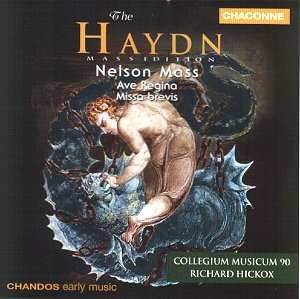
Of Haydn's last great masses, the 'Nelson' one is probably the most famous. This is in no small measure due to Sir David Willcock's outstanding Decca recording from way back in 1962 that led the way in scoring such works for chamber size forces. Of course, we have come a long way since then and this Hickox recording has been eagerly awaited since his current cycle of these choral works has been of consistently high standard throughout.
The delightful sound of period instruments lends an added urgency to this 'Missa in Anguustis'; indeed the scoring is subtly palpable and highly tense. The opening 'Kyrie' is a case in point with whirling kettledrums and acidic strings making for a splendid cocktail. Hickox's urgent tempo is very much in the mould of the Wilcox version. Susan Gritton's lovely contributions in the 'Gloria' are an added bonus and the theatricality of that movement finds Hickox tickled pink throughout. All the other soloists are impeccable although Varcoe is occasionally too studied. The ominous sounds of the Credo are beautifully portrayed whilst the usual martial overtones in the Agnus Dei are remarkably underlined.
All in all, this recording of the Nelson Mass can claim to be the most satisfying at the moment. A delightful bonus is to be found in the rare 'Ave Regina', not a masterpiece but pleasant nonetheless. The same can be said for the early Missa Brevis, short but quite profound in its choral handling. Excellent Chandos recording and the usual striking presentation should win this disc many admirers and is self-recommending for those who have taken the dip into Richard Hickox's Haydn mass series.
Reviewer
Gerald Fenech
Performance:

Sound:

and another view from Peter Grahame Woolf
Composed rapidly during summer 1798 after completing The Creation, Haydn made a virtue of necessity (dismissal of Prince Esterhazy's windband to reduce expenditure) with his theatrical and war-like scoring of the new mass for strings with only 3 trumpets, timpani and organ, which he played himself. (The Nelson association is spurious.) Its opening is arresting and the tension and exceptional beauty of this wonderful music never flags. In earlier decades within my lifetime the Haydns masses were neglected and undervalued in England as being insufficiently solemn.
This recording in Blackheath Halls has all the immediacy and tension of a live performance and rates amongst my most exciting listening of the year. The excellent soloists are well balanced with chorus and the early music orchestra Collegium Musicum 90, whose instruments are detailed in the exemplary notes. The youthful Ave Regina has an Italianate style for the soprano soloist, Susan Gritton. The Missa Brevis, composed when he was about 17, was rediscovered in his old age by Haydn himself, who took pleasure in its "certain youthful fire" with florid parts for two solo sopranos.
An enormously satisfying CD, not to be missed.
Reviewer
Peter Grahame Woolf

Gustav HOLST (1874-1934) Suite de Ballet ; A Song of the Night* ;The Wandering Scholar Chamber Opera in One Act
cast below *Lesley Hatfield (violin) Northern Sinfonia conducted by Richard Hickox
Chandos CHAN 9734 [53:39]
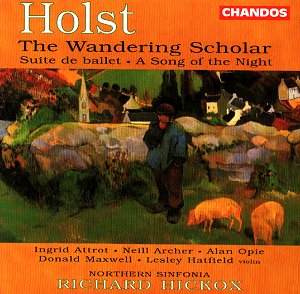
Alison………………………….Ingrid Attrot (soprano)
Pierre………………………… Neill Archer (tenor)
Louis………………………… Alan Opie (baritone)
Father Philippe……………….. Donald Maxwell (bass)
This brief but delightful programme opens with an early work, Suite de Ballet., Op. 10 (1899) which Holst wrote while he was touring with Carl Rosa. It is light music. The opening 'Danse rustique' is just that, a charming little piece with plenty of rhythmic drive, recalling Edward German and Sullivan. 'Valse' has the grace of classical ballet although one or two phrases might disconcert some choreographers into thinking them rather heavy-foooted. The 'Carnival' movement is high-spirited and evokes the hustle and bustle of the crowds and the enticements of the side-shows and fair-ground rides. There is quite a strong Gallic feeling about it yet the slower middle section uncannily pre-echoes Eric Coates's more romantic moments. But the most charming movement, is the sweetly romantic and atmospheric nocturne that is the 'Scène de nuit.'
Another lovely nocturne - Song of the Night (1905) demonstrates how far Holst's talent had progressed. This work has altogether more depth and range and shows much more confident and imaginative writing for the solo violin. Although Holst left no clue as to the specific meaning or influence of the song, we may deduce that it encompasses his enthusiasm for Indian mythology since, at the time, he was deeply immersed in learning Sanskrit and writing music with definite Indian leanings.
The main work in the programme is the brief (25 minute) one-act chamber opera, The Wandering Scholar (1929-30) that was influenced by the writings of Helen Waddell. The comedy is slight with no chorus and just four characters. Holst uses spare orchestral forces, there are no big numbers, no set-pieces, and no overture. It is a simple rural tale, told simply with original music that suggests (but is not) folk music.
The story opens with farmer Louis (a lusty yet reliable Alan Opie) wanting to take his oats with his wife Alison (a scheming, flirtatious Ingrid Attrot) but she has other ideas. As soon as she sees Louis off to market, she entertains randy Father Phillipe hinting - "…the heart should have its fling and put forth new love every Spring..." The orchestra amusingly admits the idea but, at the same time, censors it. For his part, Philippe (a really lecherous ill-tempered Donald Maxwell), is keen to get her upstairs (up the ladder anyway) to "…exorcise the naughty devil of springtime in your eye…" He is just about to have his wicked way, when Pierre enters (a knowing Neill Archer as the not-so-innocent wandering scholar). Pierre is down on his luck and begs food. To Father Philippe's disgust, Alison fancies him and wants to feed him. In a jealous rage, Philippe chases the hapless boy away. Once again, the would-be lovers go towards the ladder, fat Philipe worrying if the rungs will hold him when they hear Louis returning - with Pierre! Hurriedly, Alison hides the food and wine and pushes the fat Father beneath a clump of hay. Louis demands that Alison feeds Pierre. She is adamant that there is no food in the house and tells him to take Pierre into town for a meal. Pierre suggests he tell a tale first. Louis is enthusiastic but Alison, understandably, is not. During his fable, Pierre manages to weave into the story the whereabouts of the food and wine, and, finally. Philippe together with an allusion to his wicked intentions. Louis beats the fat man and chases him from the house then invites Pierre to sit and eat while he takes Alison upstairs…
A slight but amusing tale that Holst considerably heightens with his music.
An interesting collection for Holst admirers.
Reviewer
Ian Lace

ZOLTAN KODALY Missa Brevis, Jesus and the Traders, Evening, Matra pictures Helen Charlotte Pedersen (sop), Maria Streijffert (alto), Lars Pedersen (ten), Michael W, Hansen (bass), Torsten Nielsen (org)Danish National Radio Choir conducted by Stefan Parkman
CHANDOS CHAN 9754 [53.39]
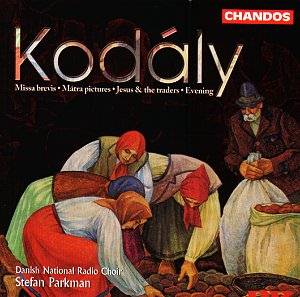
In the 60 CDs that I have reviewed so far for this website this is, without doubt, the finest. Listening to this almost faultless music was a rare experience full of intellectual and emotional significance and a telling spirituality that is second to none. When music can elevate one's spirit to both heights of aestheticism and soul satisfaction, it must be great music. The Missa Brevis is.
And the singing is of impeccable quality. Both the organ and its executant are superlative. And the recording and the engineers must take immense credit. The music is never distant or reverberant.
But it is the equality of Kodály's music that is staggering. Wonderful rich harmonies and a poignancy that has the power to move to therpatic tears. It really is a profound and rewarding experience. There are passages of unequalled beauty and power. Music like this must have the ability to encourage the pagan to think again.
Kodály is a great composer and not merely on this evidence alone. His incredible Sonata for solo cello, Op 8, of 1915 is a masterpiece too, as are his other outstanding works the Palmus Hungaricus of 1923 and the Badavár Te Deum of 1936. His orchestration is excellent as in for example, the rich pastoral shades of Summer Evening and the infectious exhuberance of the Dances of Galánta.
He was a very likeable man and a very brave one particularly during the dark days of the Second World War.
Jesus and the Traders is an unaccompanied choral piece set in Kodály's native Hungarian. It has rich textures, choice harmonies and is another 'must' for students of choral music and composers who want to excel in this genre.
Evening has a compelling evocative sound, an incredible beauty and a controlled nostalgia.
The pale beam of evening's star
Is smiling down on the world
Soon, up, up will come the full moon
A glittering, glittering canopy of heaven
Earth's noise has died away.And so to the Mátra district of Hungary for five choral vignettes which are another example of Kodály's mastery of choral composition. I have a few minor niggles but compared with the overwhelming superlative performances I can only marvel at the sensational experience that this CD has given me. Perhaps it is personal and this CD came to my desk at the right time, but it does not alter the facts of the greatness of the music and genuinely outstanding performances.
Reviewer
David Wright
Performances
(recurring)
Recording
(recurring)
There are more: Part 2 >>>>
![]() COMPETITION WIN
a CD of your Choice
COMPETITION WIN
a CD of your Choice
![]()
 Search the Crotchet database from here
Search the Crotchet database from here
| Discs
on these pages are offered for sale. There is also a page of search
engines from a selection of on-line retailers
here.
Please support this web-site by buying your discs here. Disclaimer: Every effort is made to make sales links to the correct disc but, in the end, you must take responsibility for checking that what you are purchasing is what you want. Some of these discs were not actually available for sale at the time of posting but a link has been made in anticipation of their forthcoming availablility. Any opinions expressed in reviews or articles on this site are those of the author and do not necessarily represent the views of the site owner, Len Mullenger or the Editors. Reviewers and authors retain copyright in their work unless it has been paid for or commissioned by the site owner. All prices, special offers etc relate to the month of publication only or as stated. |
Return to Index of Classical Reviews